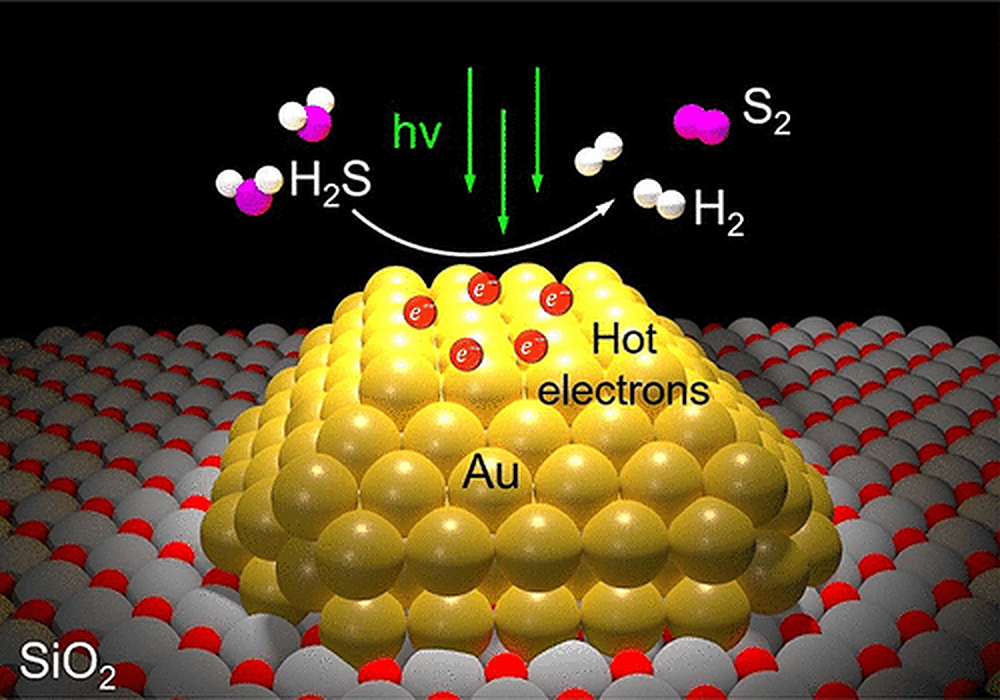Rice University scientists have revealed a way to monetize byproducts in many industrial processes, by using plasmonic photocatalysis to facilitate the direct decomposition of hydrogen sulfide into hydrogen and sulfur. Hydrogen sulfide smells like rotten eggs, due to the breakdown of organic matter in the absence of oxygen, as in swamps and sewers. It is also found in many refinery streams. “Under visible light illumination and with no external heat source, up to a 20-fold reactivity enhancement compared to thermocatalysis can be observed,” wrote the team in “Direct H2S Decomposition by Plasmonic Photocatalysis: Efficient Remediation plus Sustainable Hydrogen Production,” which was recently published in ACS Energy Letters. They explained that the “substantially enhanced reactivity” can be attributed to plasmon-mediated hot carriers that modify the reaction energetics. Light-driven, one-step decomposition of hydrogen sulfide represents an opportunity for simultaneous high-efficiency hydrogen production and low-temperature sulfur recovery, especially for petrochemical refineries.
The Sovereign Fund of Egypt and its consortium partners – Fertiglobe, Scatec, and Orascom – have officially started commissioning “Egypt Green,” Africa's first integrated green hydrogen plant. The companies said the facility will deliver up to 15,000 tons of green hydrogen as feedstock to produce about 90,000 tons of green ammonia per year at Fertiglobe's ammonia plants. Upon completion, the facility will consist of 100 MW of PEM electrolyzers powered by 260 MW of solar and wind. The consortium is now in the process of finalizing engineering and technology choices for the full-scale 100 MW plant and aims to make a final investment decision in 2023. It will build, operate and own the facility, backed by a long-term off-take agreement with Fertiglobe.
Germany and Egypt have signed two declarations of intent to intensify cooperation on the production of green hydrogen. The German government said in a statement that the declarations mark “the start of a structured dialogue with the private sector and other actors to promote the mutual exchange of knowledge and the transfer of technological expertise,” in order to clarify financing issues and “harmonize the regulatory framework.”
European Commission President Ursula von der Leyen and Prime Minister of Kazakhstan Alikhan Smailov have signed a memorandum of understanding to set up a partnership on raw materials, batteries, and renewable hydrogen. The European Union and Kazakhstan aim to identify joint projects, introduce new technologies, and enhance transparency, in addition to developing a 2023-24 roadmap. The European Commission said it expects “concrete joint actions” within six months of signing the partnership with Kazakhstan, which recently signed a separate bilateral energy cooperation deal with Germany. The commission also noted that von der Leyen is set to meet with the Namibian President Hage Geingob this week to sign a similar partnership.
BP has signed an agreement with the government of Mauritania to conduct studies to evaluate the technical and commercial feasibility of producing green hydrogen in the West African country. The UK oil and gas producer said that it will initially conduct a data collection campaign to assess the suitability of solar and wind resources at specific sites, for renewables generation and green hydrogen production.
This content is protected by copyright and may not be reused. If you want to cooperate with us and would like to reuse some of our content, please contact: editors@pv-magazine.com.



An expensive solution, a Heath Robinson machine, backed by the giants of petrol. Meanwhile, a clean way to have hydrogen has been revealed in this article of… PV Magazine : July 27, 2022, New tech to produce hydrogen from tap water (www pv-magazine com/2022/07/27/spanish-researchers-develop-tech-to-produce-hydrogen-from-tap-water/). But it’s probably more interesting to have complex stuff hold by big companies, than little autonomous energy supplies…